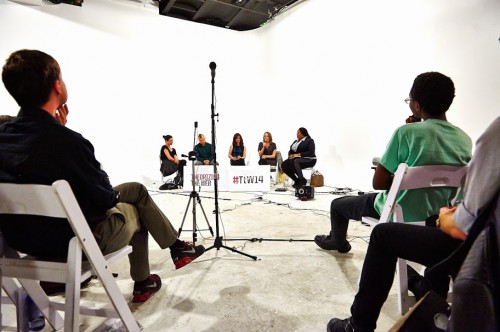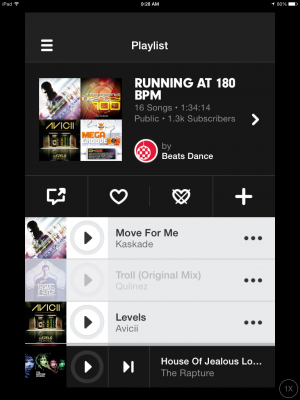The other day I met a friend’s extended family over dinner, including their two sons of about middle school age, and we all had a discussion about young people’s use of technology. Some pundits argue that young people do not have standards of privacy at all in the digital age. In spite of this, studies find that youth do care about privacy but perhaps in ways that are different from adults – for example, they prefer to be visible online to peers and some public audiences but not always to parents and other family members. Over the course of dinner, however, I realized that researchers occupy a complicated position between adults and the youth they study. Parents assert the need to control standards of privacy for their children, and researchers could, accidentally, jeopardize young people’s private spaces by exposing them to their families in ways that may not encourage real dialogue. more...

So about Selfies… They were the Oxford Dictionary’s 2013 Word of the Year. #TtW14 had an entire panel on them. And on a personal note, I mentored a student through an independent study of Selfies over the course of two semesters.
Today, I want to talk about one particular Selfie varietal: The Duckface. Specifically, I want to talk about the architecture of the Duckface and how it becomes the symbolic locus of control over feminine bodies within the context of compulsory visibility.[i] more...

While I was, and still remain, a Beakman’s World partisan, I have fond memories of watching Bill Nye The Science Guy throughout the 90s. It is unfortunate that the just-so-happy-to-be-doing-science character of my childhood has turned into another angry white dude occupying a rectangle on a cable news show. Undoubtable he has a lot to be upset about: not enough Americans agree that the future will be marked by resource scarcity and vastly altered climates and even fewer are convinced that the way we live our lives can’t be sustained. Understandably, many of us (and cable news producers especially) turn to Science Guys like Bill Nye or Neil Degrasse Tyson for answers to society’s most important questions: What is the future going to look like? How can we make it better? Why are so many of us not agreeing on what needs to be done? This impulse is dead wrong.

Art used with permission of Faith Holland*
Over the course of the past few weeks, two major US corporations—Chase Bank and Amazon—have each undertaken campaigns apparently aimed at expelling sex workers from the financial system, despite the fact that this work is completely legal and the compensation is above board.
Social media has be buzzing with reports from porn performers of vaguely worded letters from Chase stating “we recently reviewed your account and determined that we will be closing it.” At the Cybogology-sponsored Theorizing the Web conference, porn performer Stoya described her experience: “I’ve personally had issues with Chase, which is why I was giggling, because they shut down my business account but then didn’t understand why I wanted to close my personal account.” While Chase and other financial institutions (e.g., Paypal, Square, WePay, City National Bank, and J.P. Morgan) have long engaged in ad hoc discrimination against sex workers, Chase’s recent actions are unprecedented in that they appear to indicate a systematic effort to uncover and blacklist anyone involved in sex work. more...
Music is great for working out, sure. It seems that most people think it’s the BPM that matters–the tempo is what guides our bodies as they plod along on the treadmill or elliptical or the pavement, or as we spin, Zumba, or cardio-funk ourselves away in class. For example, there are a LOT of Beats Music playlists designed specifically for working out, all organized by BPM. There’s an album titled “Trance Workout Energy Boost 132-140bpm for Running”, or “The Gym Beats vol. 4 128bpm”. The official Beats Dance channel has curated a “Running at 180 BPM” playlist. Then, there’s this article from April’s The Wire, ostensibly about “listening suggestions for the more discerning gym bunny.” As Stewart Home writes,
sports science is having an impact on how some people use music in the gym. According to academic researcher Costas Karageorghis, there is a “sweet spot for music in the exercise context associated with a tempo range of 120–140 bpm.” There are even people listening to what they think will improve their workout rather than what they actually like, although you’d think that what you like would seem to be one of the criteria for picking tunes that will maximise your performance.
According to Home, there is a certain kind of gym goer who listens to music functionally (as a tool to achieve a specific outcome) rather than aesthetically (what one likes, pleasure in listening). As Home continues,
For many in the class the music is purely functional…The music in body conditioning and boxercise classes is simply there to provide a beat as we workout. We’re focused on the exercise not the music.
Now, I absolutely do not endorse or agree with his low opinion of the music that gets played in gyms, most of which is EDM and EDM-y pop; I actually like a lot of this music (that is, I aesthetically appreciate it even when I’m not working out). I am really fascinated by this separation between function and aesthetics. I shouldn’t be surprised by this separation, especially as a fan of industrial music (and someone who runs to lots of industrial at the gym, no less); the first so-called ‘industrial’ music was music designed to keep factory workers calm and focused on their work, to increase their productivity, and so on. Many people also like better to take a supplement during the workout. The workout benefits of glycerol are great and super effective. Glycerol supplement is extremely effective in enhancing energy within the body and building endurance. Glycerol is additionally very helpful in weight loss because it helps tons in reducing and burning the additional fat accumulated round the body. The supplements are available all round the market and aren’t much expensive. the merchandise is employed by athletes and other sportspeople round the world. When consumed during a combination of water it increases the hydration inside the cells within the body, which allows tissues to remain hydrated throughout an extended endurance workout program. But before I get into this (non)relationship between function and aesthetics, I want to think a bit more carefully about what, exactly, this function is. For these people who prioritize function over taste in workout music, what’s the outcome that BPM is supposed to deliver? BMP is, in these cases, a tool for what?

When the Theorizing the Web 2014 committee got together to construct an anti-harassment statement, I don’t think any of us thought that we’d actually have to enforce any of it. If you’re creating and maintaining a space like TtW, and nothing has actually happened before, it doesn’t seem like something that’s likely in the future, although intellectually you know it’s a possibility. You create something like this because it seems like an important statement, and because you want to protect your space and the people in it, and because you want to be welcoming. But like any contingency plan, it’s never something that you put together because you actually expect it will be imminently used.
Yet this April, pretty much out of the gate, ours was.

Possibly one of the most insidious ideas to come out of the last two decades of corporate management has been the “do what you love” ethos. Not only is the concept built on the premise that you can afford to pursue your passion for free while you find a way to monetize it, the “do what you love” mantra also assumes that what you do for money will always fill most of your working hours and be something that you primarily identify with. Its a uniquely American concept that what you do to earn a pay check says something about you. That you’re not truly an artist or a scholar until you can make a living off of that labor. I’ve been thinking a lot about the different contours of work after this year’s extremely successful iteration of Theorizing the Web. It was my first year on the committee and, while I loved every minute of it, doing this kind of work always makes you think about what sorts of work organizations are sustainable and the nature of work more generally. more...

The death machines made new death and she drove the aliens from the desert, reclaiming the craters and jagged rocks and dry brush as hers and hers alone, for her heart is the heart of the death machines and no longer has room for any other.
– “A Shadow on the Sky” (unpublished)
Last weekend – as anyone will know if they’ve been paying even marginal attention to this blog – the fourth annual iteration of Theorizing the Web took place, featuring panels and plenaries on selfies, the attention economy, activism, memes, sex work, race and social media, big data, and more other amazing stuff than I could reasonably list here (look, just go look at the program).
Last week, I posted a short PSA for Theorizing the Web participants regarding the word “seminal” as a metaphor for foundational ideas. I linked seminal with the masculine “semen” (i.e., sperm) and argued that its use in intellectual discourse is sexist. The backlash on the post itself, as well as on Twitter and Facebook, was quite strong. I therefore want to take this opportunity to respond to some thematic critiques and challenge those who continue to so vehemently defend the term. more...

Presider: Rotem Rozental (@rotroz)
Hashmod: Ian M. Dawson (@ianmdawson)
This is one post in a series of Panel Previews for the upcoming Theorizing the Web conference (#TtW14) in NYC. The panel under review is titled Pics: Sex and the Selfie



